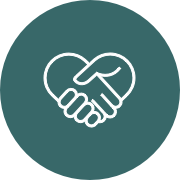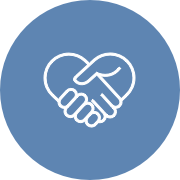Breaking the Silence: Why Mental Health Awareness Matters at RHD and Beyond

May 2, 2025
Understanding Mental Health: Beyond the Basics
Nearly 1 in 5 adults in the United States experiences a mental health condition each year. ¹ Yet despite how common these challenges are, many people still struggle in silence.
Mental health conditions exist on a spectrum. The National Institutes of Health (NIH) categorizes mental illnesses into two main classifications:
- Any Mental Illness (AMI) encompasses a broad range of mental, behavioral, and emotional disorders that vary in severity. ¹
- Serious Mental Illness (SMI) involves disorders that significantly impact daily functioning and limit major life activities. ¹
This distinction helps health professionals provide appropriate care tailored to individual needs. Whether someone is experiencing mild anxiety or a more complex condition, understanding these classifications can help guide treatment approaches.
Most importantly, we want everyone to know that recovery and effective management of mental health conditions are possible with proper support and treatment.
Breaking Down Stigma: Mental Health Myths vs. Facts
One of the biggest obstacles to mental health care remains the persistent stigma surrounding these conditions. Let’s address some common misconceptions: ²
Myth: People with mental health conditions are violent.
Fact: Most people with mental health conditions are no more likely to be violent than anyone else.
Myth: People with mental health needs, even those who are managing their mental health conditions, cannot tolerate the stress of holding down a job.
Fact: People with mental health conditions can be just as productive as other employees, especially when they are able to manage their condition well.
Myth: It is impossible to prevent a mental health condition.
Fact: Prevention of mental, emotional, and behavioral disorders focuses on addressing known risk factors, such as exposure to trauma, that can affect the chances that children, youth, and young adults will develop mental health conditions.
These facts highlight the importance of education and awareness in changing public perceptions about mental health. Some say, “If you can’t see it, it’s not real.” That, in itself, is a myth. Mental health struggles are just as real as physical health conditions, even if they aren’t always visible.
Recognizing Burnout: More Than Just Being Tired
Burnout is increasingly recognized as a serious condition that affects both mental and physical health. It’s more than just feeling tired or having a bad day at work—burnout represents a state of chronic stress that leads to:
- Physical and emotional exhaustion
- Feelings of cynicism and detachment
- A sense of ineffectiveness and lack of accomplishment
Many people experience burnout, especially healthcare workers, parents, caregivers, and essential workers. Recognizing the signs early can prevent more serious mental health consequences.
Warning signs include:
- Feeling drained most of the time
- Decreased satisfaction and sense of accomplishment
- Withdrawal from responsibilities and relationships
- Relying on unhealthy coping mechanisms
- Changes in sleep habits or appetite
- Frequent physical symptoms like headaches or stomach problems
Simple Self-Care Practices Anyone Can Try
Self-care doesn’t have to be expensive or time-consuming. Here are some accessible practices that can make a significant difference in your mental wellbeing:
- Connect with nature: Spend just 15-20 minutes outside each day. Whether it’s a walk in a local park, sitting under a tree, or tending to a small garden, connecting with nature has been shown to reduce stress hormones and improve mood.
- Practice mindful breathing: Take five minutes to focus on your breath. Inhale slowly for a count of four, hold for a count of two, and exhale for a count of six. This simple technique can help activate your parasympathetic nervous system, reducing anxiety and promoting calm.
- Move your body: Physical activity releases endorphins that naturally boost mood. Even gentle movement like stretching, walking, or dancing to your favorite song can help shift your mental state.
- Create healthy boundaries: Practice saying “no” when you need to. Setting limits on your time and energy is an essential form of self-care that prevents burnout.
- Express gratitude: Each day, write down or mentally note three things you’re grateful for. This practice has been shown to shift focus from what’s going wrong to what’s going right, improving overall outlook.
- Limit media consumption: Be mindful of how news and social media affect your mood. Consider setting specific times to check updates rather than constantly scrolling.
Remember that self-care is not selfish—it’s necessary for maintaining the energy and resilience needed to care for others and meet life’s challenges.
Starting the Conversation: How to Support Mental Health
A simple conversation can make a difference in someone’s mental health journey. Here are three ways to start one:
- Check in meaningfully: “I’ve been thinking about you and wanted to see how you are doing. How have you been feeling lately? I’m here to listen without judgment.”
- Practice active listening: Try to avoid interrupting or offering unsolicited advice. Simply listening and acknowledging someone’s feelings can be incredibly powerful.
- Encourage professional support: “You don’t have to face this alone. Have you considered talking to a therapist, counselor, or support group? I’d be happy to help you find resources if you’re interested.”
Speaking up about mental health not only reduces personal suffering but can inspire others to seek support, too. Your conversation could change a life.
RHD’s Commitment to Mental Health: Safe, Person-Centered, and Comprehensive
At Resources for Human Development (RHD), we believe it’s time to change the conversation around mental health—starting with awareness, education, and compassionate support.
Since 1970, RHD has been dedicated to providing that support through compassionate, personalized care across multiple states including Delaware, Tennessee, Iowa, North Carolina, Louisiana, and Pennsylvania.
At the core of RHD’s philosophy is our commitment to fostering a Safe and Open Culture. This isn’t just a value we post on our walls—it’s how we approach every interaction and service we provide.
We understand that healing becomes possible when people feel safe to communicate openly without fear of judgment or negative consequences. This approach applies both to the individuals we serve and to our broader community conversations about mental health.
Our mental health services include:
- Behavioral Health Programs providing specialized support for individuals with various mental health challenges
- Residential Support for individuals with intellectual and developmental disabilities
- Recovery Programs for people dealing with addiction issues
- Resources for People Experiencing Homelessness to address the often-overlooked mental health needs of this vulnerable population
- Job Training, Assisted Transportation, and Crisis Intervention to support holistic wellbeing
All our programs are designed with the understanding that mental health is influenced by many factors, including housing stability, employment, community connections, and access to resources.
Taking Action for Mental Health
While Mental Health Awareness Month offers a timely spotlight, remember that mental wellness is an ongoing priority. Here are ways you can continue supporting mental health year-round:
- Share resources with those who might need them
- Practice regular check-ins with friends, family, and colleagues
- Advocate for mental health access in your community
- Prioritize your own mental wellbeing through regular self-care practices
- Learn to recognize warning signs in yourself and others
Mental health deserves our attention every day of the year—not just in May.
Learn more about RHD’s programs: www.rhd.org/our-programs/
Access our Behavioral Health resources: https://www.rhd.org/program_area/behavioral-health/
If you or someone you know is experiencing a mental health crisis, contact the 988 Suicide & Crisis Lifeline by calling or texting 988, or visit 988lifeline.org.
¹ National Institute of Mental Health (NIMH). “Mental Illness.” https://www.nimh.nih.gov/health/statistics/mental-illness
² Substance Abuse and Mental Health Services Administration (SAMHSA). “Mental Health Myths and Facts.” https://www.samhsa.gov/mental-health/what-is-mental-health/facts


